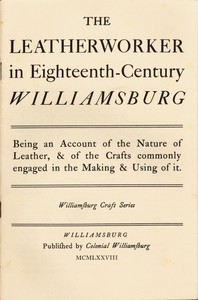Craftsmen in 18th Century Williamsburg

The Leatherworker in Eighteenth-Century Williamsburg by Thomas K. Ford and Harold B. Gill Jr
The good people of Williamsburg, Virginia, have produced a series of booklets on craftsmen operating there during the 18th Century and generously made them publicly available on Project Gutenberg.
While my site is about 18th Century Britain, the technologies in the Old World and the New would have been much the same. I have extracted some of the more relevant material but I urge you to look at the complete publication. Click on the cover illustration to go to the Gutenberg page.
The following extract describes how Williamsburg leatherworker William Pearson would have treated hides.
Preparing Leather
It is hardly a secret that the processes of tanning and currying infuse the surrounding air with a symphony of odors—a circumstance that helps to explain why a tannery was generally located on the far edge of a town, and usually on the downwind side. As if hides and skins were themselves not fragrant enough, eighteenth-century tanners, curriers, and leather dressers made use at various stages or for special purposes of such delectable commodities as fish oil, sour beer, urine, barley mash, and the fermented dung of chickens, pigeons, and dogs.
Sketchily described, the procedures employed by the tanner and currier (separate crafts in England but often combined under one roof or in the same man in colonial America) were as follows:
1) Preparing the pelt included the removal of accumulated dirt and stable trash, removal of the hair and epidermis from the outer or grain side (except for furs), removal of shreds of flesh and adipose tissue from the inner side, and plumping up of the fibers of the remaining middle layer, or corium, to be more receptive to the tanning solution. The tanner accomplished all this by repeated washings, followed by a sequence of soaking in solutions of lime, and then by draining, and scraping. The scraping process, known as unhairing and fleshing, he did laboriously with a blunted knife, the pelt being stretched over a wooden horse or beam. He might repeat the liming, draining, and scraping if necessary, and he followed it up with more rinsing and scraping to remove most or all of the lime.
2) Tanning proper involved soaking the hide or skin in a series of tanning vats, each containing a stronger solution—called “ooze”—than the one before. Careful and complete tanning, a slow process, required from several weeks for a light skin to eighteen months for a heavy hide. During this period the hides or skins were many times “hauled and set,” that is, removed from the vat and piled beside it to drain for a time. The same sort of processing took place in tawing, except that alum rather than oak bark supplied the tanning agent.
3) Finishing included trimming, currying, and coloring (if called for) in whatever combination of processes was needed for the intended use of the finished leather. Readers with uneasy stomachs should be satisfied if some of these processes are here left undescribed, only named, to wit: trampling, scouring, blooming, slicking, stricking, shaving, stuffing, dubbing, boarding, graining, bruising, staking, waxing, blacking, sizing.
Altogether, William Pearson might have subjected a hide to as many as two hundred separate steps (repetitions included in the count) in its passage from the animal’s back until delivery as finished leather to a shoemaker, saddler, bookbinder, or other leather using craftsman. The total time consumed would have been anything from a few months for a lambskin, for example, to more than two years for a thick ox hide.

